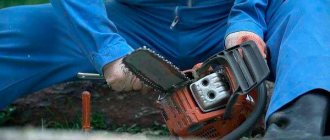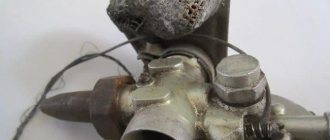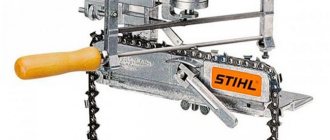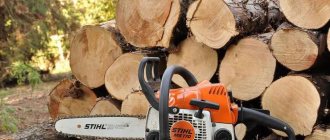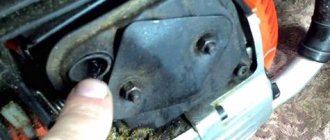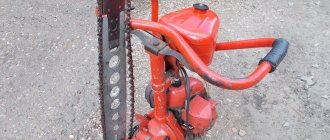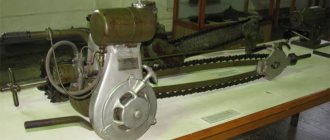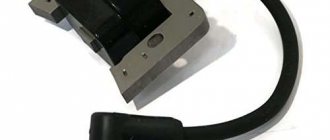A chainsaw is a highly efficient tool that is designed for working with wood. However, the high-speed motor of this tool can be used to perform a number of other tasks, which is achieved through special attachments. Sometimes a malfunction occurs such that the chainsaw stalls when you press the gas, which can be triggered by certain factors. To avoid having to completely disassemble the tool, we will consider all possible causes of this problem with a detailed description of how to eliminate them.
Where to look for the reason or where to start checking
All chainsaws have the same design and work on the same principle. The structure of a chainsaw can be found in this material. It doesn’t matter much what brand the instrument is - Shtil, Husqvarna, ECHO, Champion, Partner, Sturm and others. A malfunction that manifests itself in the form of a chainsaw stalling when you press the gas can occur equally on both expensive and high-quality tools and on budget Chinese devices. If a problem arises, it needs to be solved.
A chainsaw is a system of mechanisms consisting of parts. Any part in the mechanism can fail, which will lead to partial or complete failure of the tool. If the tool’s engine starts, this does not mean that the chainsaw is fully operational. When the engine stops working when the speed increases, there are corresponding reasons for this. In case of this malfunction, you should first pay attention to a number of the following tool mechanisms:
- Gas tank - make sure there is fuel. If there is sufficient fuel, you should also check the serviceability of the fuel filter, the connection of the supply hose to the carburetor, and also make sure that the breather is working
- Spark plug - if everything is in order with the fuel supply system, then you should check the serviceability of the spark plug. By the color of the carbon deposits on the spark plug electrodes, you can determine the cause of the breakdown. If the carbon deposits are brown, then the spark plug, ignition and fuel supply system are operating in the correct mode. The presence of black carbon deposits indicates an ignition malfunction, and if the electrodes are wet, then the carburetor should be checked
- Muffler - over time, carbon deposits accumulate in the exhaust gas removal device, which helps reduce the throughput of the mechanism. If the exhaust gases have nowhere to go, they will interfere with the normal operation of the engine. In addition to a decrease in power, if the muffler is faulty, the engine will stop working when the speed increases
These are the main parts and mechanisms that should be checked first if a malfunction occurs when the chainsaw stalls when the accelerator is pressed. There are other reasons why a chainsaw engine stalls when the gas trigger is pressed. What else can contribute to the occurrence of this malfunction, as well as the specifics of troubleshooting, we will find out further.
Electrical equipment
Malfunctions of the ignition system are determined quite simply by checking the spark plug and adjusting the gap in the contacts. After checking the integrity of the wiring, the causes of the failure should be sought in the operation of the electronic unit.
The absence of a spark at the contacts may be a consequence of a breakdown of the noise suppression resistor located in the body of the spark plug. To check its integrity, simply connect the high-voltage wire to the spark plug directly.
Adjusting the carburetor when the engine stalls when revving up
If the check shows that the fuel supply system, muffler and spark plug are working properly, then you need to look for a breakdown in other places. Initially, do not rush to disassemble the cylinder-piston group or change the carburetor. It is recommended to start repairs by adjusting the carburetor. For this, all chainsaws have special adjustment screws. They are designed to adjust idle speed, as well as adjust fuel supply at low and high speeds. A detailed description of how to adjust the carburetor of a chainsaw is described on the website.
Today we will look at the features of setting the carburetor at maximum speed. You can make sure that the chainsaw is not developing full power using a tachometer. If there is no device, then you can make sure that the engine is not developing maximum speed by ear. We are interested in the screw on the carburetor. Which is designed for high speed settings. It is usually denoted by the Latin letter "H", which is short for the word "High" (high or large).
To set up high speed chainsaws you will need to perform the following manipulations:
- Screw screw H clockwise until it stops
- Next you need to loosen it by 1.25-1.5 turns
- Start the tool and test the speed performance
It is recommended to make the adjustment using a tachometer, but if you don’t have one, you can check the maximum speed when working with the tool under load.
This is interesting!
If you often work with a chainsaw, then you will need to purchase a tachometer, as it allows you to set the engine to operate as efficiently as possible, which affects the fuel consumption and power of the unit.
After simply adjusting the carburetor, you can fix the problem with the engine stopping when the speed increases. It should be noted that the chainsaw carburetor must be adjusted regularly depending on the frequency of use of the tool. It is not difficult to do this yourself, but precise adjustments can be achieved in one case - if you use a tachometer.
Turning off the engine in operating mode
Alternatively, if the chainsaw heats up and stalls, troubleshooting should be done in the carburetor settings or in the high-voltage circuit of the ignition system unit.
When it overheats, the spark disappears or becomes so weak that its power is not enough to fully ignite the fuel-air mixture.
The engine also stalls when hot if the anti-interference resistance, which is located in the tip of the spark plug, is faulty.
Why else might a chainsaw stall when you press the gas?
If after adjusting the chainsaw carburetor the problem remains, then you should resort to checking a number of other factors. There are enough such factors, and they must be checked sequentially, moving from easier to more complex. It is in this order that we will consider all the reasons why the chainsaw does not develop high speeds and stalls. It should be noted that in this case the tool starts and works properly at idle speed.
- Check the chain tension - if you tighten the cutting element too much, this will create a strong load on the engine. In this case, it will be difficult for the high-speed engine to turn the chain, as a result of which we get it to stop working. The problem can be corrected if the chain tension is adjusted correctly. The chain should rotate easily by hand, but also keep in mind that it should not move at XX. If the chain moves at idle, then you need to adjust the upper XX screw
- The quality of the fuel mixture and the correctness of its preparation. It is recommended to use AI-92 gasoline for chainsaws. It is mixed with two-stroke oil in appropriate proportions. Although the mixing proportions are indicated on the label of the oil container, you must use the data provided by the tool manufacturer. The optimal mixture of gasoline and oil is 40/1, that is, for 1 liter of gasoline you need to add 25 ml of oil. The proportion means that for 40 liters of gasoline you need to add 1 liter of oil. If you do not adhere to the manufacturer’s recommendations, this will ultimately negatively affect the operation of the carburetor and the serviceability of the CPG
- Muffler - very often sawmills do not pay due attention to the exhaust system of the tool. If the muffler becomes clogged, and this inevitably happens over time, this will negatively affect the operation of the engine. Mufflers on chainsaws are either collapsible or non-dismountable. In non-separable devices, the connections are flared, so in case of clogging, you need to either replace the part or flare it for cleaning. A clogged muffler affects the operation of the tool, so you should not wait until the chainsaw stops starting
- Air leakage - parts and mechanisms of the chainsaw are connected to the cylinder through sealing gaskets. As a result, such connections are sealed, which is important for the operation of the internal combustion engine. You can verify this malfunction by tightening the bolts and nuts that secure the carburetor and muffler. Leaking can also occur due to deterioration of the gaskets, which should be replaced on the tool
- Fuel and air filters are elements responsible for filtering the air and fuel mixture. If the air filter is clogged, then when the throttle opening is increased, sufficient air will not flow into the carburetor, which will lead to flooding of the spark plug. As a result, the engine will stall when trying to develop maximum speed. If the fuel filter is faulty, the required amount of fuel does not enter the carburetor. Its deficiency leads to the fact that the tool cannot develop speed and immediately begins to stall
- Availability of a fuel filter. This element can not only become clogged, but also become disconnected from the fuel hose. As a result, it will turn out that contaminants will get into the carburetor, which will very quickly damage the mechanism
- A breather is a hole through which air enters the chainsaw tank, thereby preventing the creation of a vacuum inside the sealed container. The breather is located on the gas tank cap or can be built into the wall of the tank. The principle of its operation is such that as the gasoline in the tank is consumed, the container is filled with air. If the breather is faulty, a vacuum is created in the tank, which prevents fuel from being pumped into the carburetor. The breather allows air to flow in one direction and eliminates the possibility of fuel leaking out of the tank. You can repair the part using a thin needle, which makes a hole
- CPG malfunction - the chainsaw does not pick up speed even if the cylinder-piston group is worn out. To identify this reason, there is no need to disassemble the engine to look inside. You should use a compression meter to check the amount of compression. The normal value should be at least 12 atmospheres, and if the value is lower, then the CPG must be replaced
- Ignition System - If the engine starts, it is unlikely that the problem is an electrical problem. However, it would not be superfluous to unscrew the spark plug and perform a visual inspection of it. The presence of black carbon deposits indicates the need to check the ignition. The first thing you need to check is the gap between the ignition module and the flywheel, the value of which should be 0.25 mm. The integrity of the armored wire is also checked, and if it is damaged, it must be replaced along with the module. Spark plugs have a corresponding resource, so they need to be changed, first setting the gap to 0.5-0.7 mm (indicated in the technical description for each tool model)
If checking all the reasons does not allow you to achieve a positive result, then you should remove and clean the chainsaw carburetor.
This is interesting!
Make sure fuel is entering the carburetor. To do this, you need to disconnect the hose from the carburetor and look at the activity of the stream. If the fuel flows quickly, then everything is in order, and this factor can be eliminated.
Setting up the fuel system
Qualified carburetor adjustment allows you to bring the power unit to a combination of maximum traction parameters and economical fuel consumption.
The success of the work is facilitated by preliminary cleaning of the air intake filter, warming up the engine to operating temperature, and performing adjustments in the sequence specified in the instructions.
The result of correct carburetor adjustment is:
- rapid acceleration without the “failure” characteristic of a lean mixture when accelerating sharply;
- absence of increased smoke from the muffler;
- stable idle speed.
Chainsaw stalls at high speeds - simple carburetor repair
The carburetor of a tool is precisely the mechanism that most owners are afraid to disassemble on their own. The reason is that this mechanism consists of many small parts, the location of which must be remembered during dismantling work. However, not everything is as scary and difficult as it might seem. To understand how the carburetor relates to the problem of the engine stopping when the speed increases, you need to know its operating principle, described on the website.
The chainsaw stalls when you press the gas due to the carburetor if:
- Damaged membrane
- Clogged filter element (mesh in the carburetor). This malfunction may be encountered by tool owners who do not have a fuel filter or it is simply disconnected from the fuel hose.
- Needle sticking, which may be due to the use of an outdated fuel mixture
- Clogged jet channels or clogged carburetor
- Bending the connecting part that combines the membrane with the needle to supply fuel to the fuel chamber of the carburetor. This part is also called the foot, since under the influence of the membrane on it, the needle moves and the channel opens. During operation, this foot may bend (wear out) or break (if broken, the engine will not start). If the foot is bent, it can be straightened, but this does not guarantee that the problem will recur soon, so it is recommended to replace the part
It is recommended to clean and wash the chainsaw carburetor, as well as replace faulty parts and elements. After this, you can put it back, not forgetting to also replace (if worn) the sealing gasket between the carburetor and the adapter.
Elimination of fuel equipment failures
A simple analysis of failures and malfunctions shows that most of them are due to unqualified tuning of the fuel system. Upon closer examination, it turns out that the reasons for the situation when the engine does not start, does not pick up speed and stalls are practically the same.
In most cases this is:
- air leakage due to loosening of screw fasteners or destruction of the crankshaft oil seal;
- contamination of jets;
- float valve leakage;
- Wear of the booster pump seal.
Why does a chainsaw stall when the accelerator is pressed - to summarize
When making an upgrade for the reasons why the saw stalls after you press the gas, it is necessary to take stock of all possible reasons and eliminate them. The reasons can be divided into two parts - simple and complex. You need to start troubleshooting with simple causes and end with more complex ones.
You definitely need to start checking from the tank, not from the carburetor, but from the gas tank. Moreover, make sure that the correctly prepared mixture is used. Next, you need to check the serviceability of the muffler and the presence of carbon deposits on the spark plug. After this, you will already have an idea of in which part of the tool you need to look for a breakdown. There may be a breakdown in that. What you need to do is simply turn up the maximum speed, for which you adjust the carburetor. If this does not solve the problem, then you should check the air filter and clean it.
Pay special attention to the carburetor, after cleaning and possibly repairing which the chainsaw should work like new. If even after this the problem remains, then do not be lazy to check the compression value. Perhaps the engine is very weak and needs to be replaced.
At this point, the upgrade to restore the functionality of the tool is completed, and it is worth noting one more point, such as the use of fuel that has been stored for a long time. Many people dilute gasoline with oil and store the mixture for months, and sometimes for six months. This cannot be done in any way, since the mixture has the properties of aging, and therefore, after its preparation, it must be used within 1-2 weeks. If you do not follow this recommendation, you will need to frequently change not only the fuel filters, but also clean the carburetor, but the worst thing is that this contributes to accelerated wear of the CPG.
Mechanical problems
A sudden stop of the chainsaw can be caused by jamming of the piston in the cylinder or destruction of the crankshaft bearing due to oil starvation or poor quality of engine oil.
In the first case, the functionality of the tool can be restored by pouring a few drops of engine oil into the spark plug hole. Elimination of damage to the crank mechanism requires complete disassembly in a well-equipped workshop.
Carburetor operation in winter
People who work with chainsaws have repeatedly noticed that an inexpensive tool that works great in the summer loses its performance in the winter. For example, the “Partner” chainsaw, which works flawlessly in warm weather, stalls with the onset of cold weather. What is this connected with? On saws of an expensive price category, the carburetor has two operating modes - winter and summer. Initially, the chainsaw is configured for the summer. In order to switch it to cold operation mode, you need to open a special damper. Then air will be sucked into the carburetor not from the street, but from the hot cylinders, which will ensure stable operation in the cold. However, this solution does not solve the problem of cold starts in winter.
What to do
If a malfunction is detected, you can try to fix it yourself.
If you can’t fix the device yourself, contact a specialist. The technician will inspect the device and make professional repairs. This will avoid the risk of damaging the instrument when trying to repair it with your own hands. Methods for eliminating dysfunctions depend on which part turned out to be faulty, causing the saw to malfunction. If the chainsaw starts and immediately stalls, the cause is often a lack of fuel. You should monitor the amount of fuel liquid in the gas tank and refill the device in a timely manner.
It is important to operate the tool correctly, following the instructions. Using a chainsaw for other purposes may impair the quality of the cut and lead to breakdown or damage to the device.
New equipment can be difficult to start even with an easy start system. After some time, this problem resolves itself. If a person has doubts about the serviceability of the device, it is recommended to consult a specialist.
A simple way to determine the quality of the mixture
The easiest and most affordable way to check the quality of the mixture is the central spark plug insulator. A brown color of any intensity indicates proper carburetor adjustment.
The consequence of working with a rich mixture is the formation of black soot on the insulator, while a lean mixture manifests itself as a pure white or light gray insulator.
If, after normal starting and warming up, a fuel-filled saw periodically stalls during operation, it is recommended to eliminate the vacuum in the gas tank by cleaning the breather. The cause of unstable engine operation may be condensate water that has entered the carburetor float chamber.
Echo CS 260TES 10” – areas of application and standard equipment
This Echo chainsaw is great for home use. It has a simple design, which makes tool repair quite convenient and quick.
This model is considered the lightest in its class, equipped with a system to facilitate starting and an effective inertia brake. Unit characteristics include:
- Cylinder volume – 27 cm3;
- Saw power – 1.7 l. s., or 1.2 kW;
- Fuel tank capacity – 245 ml;
- Working weight – 4.4 kg.
This chainsaw successfully copes with sawing small logs, as well as cutting down dry branches. The tool kit includes a chain, bar, case and documentation.
Echo CS 361WES 14” – design and advantages
The design of this model includes a high-quality motor with a forced air cooling system, a modified clutch and an effective vibration damping system.
Among the advantages of this model are low oil and fuel consumption, low weight and a balanced center of gravity. Other features of the unit include:
- Cylinder volume – 36 cm3;
- Saw power – 2.3 l. s., or 1660 watts;
- Fuel tank capacity – 325 ml;
- Oil tank volume – 235 ml;
- Operating weight – 6 kg.
This saw copes well with harvesting wood for household needs and construction, and can also be used to lighten forests.
Little tricks
You will learn further about what to do if the gasoline trimmer does not gain momentum.
When the scythe stalls at high speeds, this is due to the following problems:
- clogging or sticking of the valve located on the gas tank cap;
- the carburetor has become misregulated due to vibrations that occur during operation of the mechanism;
- problems with the circulation of fuel mixture;
- atmospheric air suction;
- the hose designed to collect fuel is cracked or loosely connected.
The carburetor is adjusted, focusing on the operational instructions for the trimmer. For an option, it is often enough to loosen the tightening of its housing. If there are problems with the circulation of the fuel mixture, then it can gradually enter the carburetor. After it is exhausted, the engine stalls at high speeds.
At idle, the most common reasons for the trimmer stopping are the following:
- contamination, misadjustment, or otherwise incorrectly configured carburetor adjustment;
- air filter clogged;
- reduction in gearbox speed when it heats up, which is a consequence of using an unsuitable fuel mixture;
- throttle valve clogged;
- air entering the system;
- There is not enough fuel when the lawn mower is working.
If the problem area is the carburetor, then the equipment will stop both during a “cold” and “hot” start.
The unit may stall immediately after starting if the carburetor, as it is also called, was incorrectly configured - this causes an uneven supply of fuel. The result of this will be that the device begins to vibrate clearly. To eliminate problems, the carburetor is reconfigured, following the instructions for the mechanism.
Air filter clogged
The main reason for a clogged air filter is fine dust generated when sawing wood. Cutting raw wood is especially hard. Of all the reasons for a chainsaw stalling, this is the most common. The exception is some models. For example, a “Calm” chainsaw stalls for various reasons, but not because of a clogged air filter. Because its carburetor is equipped with a compensator that takes in air if the filter fails.
Wood dust particles penetrate under the housing and are sucked into the filter installed on the carburetor. A clogged mesh creates resistance to air, and less air enters the carburetor.
In order to clean the air filter, it is necessary to remove the closing cover and separate it from the carburetor.
Before removing, you need to brush off the sawdust or blow with air. Then remove the filter so that debris does not get into the carburetor. During cleaning, cover the carburetor with a cloth.
Then the filter must be blown out from the inside with compressed air, and then installed in place.
Process description
If the chainsaw carburetor is not adjusted and it is not possible to start the chainsaw, then the adjustment begins by installing screws (L) and (H) to the standard setting position. This is 1/5 turn of the screws until they are fully tightened. After which, you need to start the engine, let it run a little and warm up. The next step is setting the low speed mode. Optimal engine operation at low end can be achieved by adjusting the screw (L) and idle speed (T). To do this, first screw (L) is tightened until maximum engine speed is reached, then released by 1/4, and screw (T) is used to return the idle speed to normal.
After adjusting the operation at the “lower” range, the traction and maximum engine speed are adjusted. To do this, slowly tighten the screw (H) and check the speed using the readings of the electronic tachometer.
An important step is to check the saw in all operating modes after adjusting it; to do this, you need to let the chainsaw cool down, and then start it according to the cold tool starting algorithm. If the saw starts up normally and idles smoothly, you need to check how it cuts. If during the inspection process shortcomings in the power of the chainsaw are discovered, then it is necessary to repeat the adjustment of the screw (H) by unscrewing it and checking the traction in operation.
User manual
Any configuration with a Husqvarna 240 chainsaw must include an instruction manual for this model. After reading the user manual, you can find out:
- how to assemble and prepare the Husqvarna 240 for work;
- basic requirements for the safe use of a chainsaw;
- get practical advice on work;
- learn how to properly prepare the fuel mixture and refuel;
- how to store a saw for long-term storage;
- how to adjust the carburetor of a chainsaw with your own hands;
The Husqvarna 240 manual was developed by professionals who know how to work correctly and carry out preventive measures aimed at increasing the service life of the chainsaw. It is for this reason that you should not put the instruction manual aside, but be sure to read it.
The instructions for the Husqvarna 240 saw can be downloaded from our catalog of manuals.
Echo CS 352ES 14” and CS 353ES 14” – design features of the saw
These models are intended for regular use for domestic purposes, as well as for logging.
They have an improved design, which includes an automatic oil supply system, a vibration damping device and an inertia brake.
Other features of chainsaws include:
- Cylinder volume – 34 cm3;
- Model power – 2.12 and 2.1 liters. With.;
- The capacity of the fuel tank is 320 and 260 ml, respectively;
- The volume of the oil tank is 200 and 250 ml, respectively;
- Operating weight – 5.6 and 6.2 kg, respectively.
Each saw includes a chain, guide bar, durable case, combination wrench and documentation.
Model Echo CS 452ESX – design features of the chainsaw
This Echo chainsaw is successfully used both for domestic purposes and for felling forests. The saw design includes a durable magnesium alloy crankcase, a durable clutch drum with a removable ring, a forged connecting rod and crankshaft. Among the technical characteristics of the unit, the following should be highlighted:
- Cylinder volume – 45 cm3;
- Saw power – 2.26 kW or 3.1 l. With.;
- Oil tank capacity – 270 ml;
- Operating weight – 7.3 kg.
This Japanese chainsaw is distinguished by a unique motor layout, proper balancing and comfortable ergonomic handles.
Other advantages include economical fuel and oil consumption.
Specifications
For convenience, all characteristics are summarized in one table, and the most important ones are highlighted in green.
| Manufacturer | Husqvarna |
| Model | 240 |
| Homeland of the brand | Sweden |
| Country of Origin | China |
| Saw class | Domestic |
| Engine | |
| Power, hp /kW | 2/1,5 |
| Engine capacity, cc. | 38,2 |
| Saw set | |
| Tire length, cm/inches | 40/16 |
| Chain pitch, inches | 3/8 |
| Chain thickness, mm | 1,3 |
| Number of links, pcs | 56 |
| General characteristics | |
| Fuel tank volume, l | 0,3 |
| Oil tank volume, l | 0,2 |
| Warranty, months | 12 |
| Weight, kg | 4,7 |
| Price, rub | 11990 |
| Current price | To know |
The saw has a power of 1.5 kW with a cylinder displacement of 38.2 cm³, which is a rather modest figure among its competitors. This power is enough to be able to install a bar up to 16 inches long on the saw, but no more. Husqvarna is distinguished by the fact that its tank volumes are balanced, so fuel and chain oil run out at the same time. The type of chain used is H37. The recommended working length of the splint is 33-40 cm.
The Husqvarna 240 engine is capable of reaching up to 9000 rpm, which is also not the maximum among saws of this class. For example, Shtil 180 is capable of spinning up to 13,500 thousand.
We recommend that you look at the characteristics of the Stihl MC 180 chainsaw and compare them with the Husqvarna 240 model, you will see that they are very similar, the only advantage the German has is in weight - it is almost 1 kg lighter, but the price is 20-25% higher. Most likely it's a marketing issue. The Shtil company, in particular the MC 180 saw model, is highly advertised on the Russian market, but Husqvarna saws are simply undervalued.

